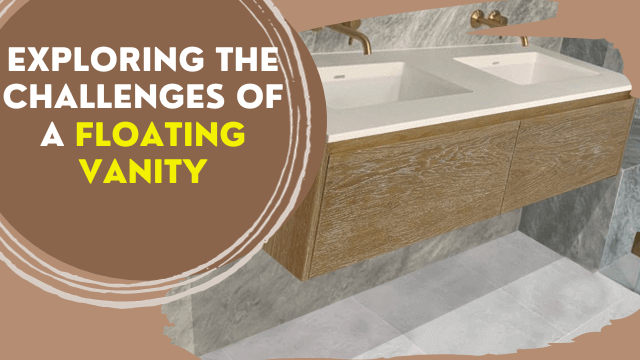Exploring the Challenges of a Floating Vanity (Should You Buy One?)
When it comes to bathroom design trends, floating vanities have become quite popular in recent years. These modern and sleek fixtures can transform the look of your bathroom, giving it an airy and contemporary feel.
However, like any design choice, floating vanities come with their share of challenges.
Before purchasing a bathroom vanity, it is critical to consider all aspects. In this comprehensive article, we delve into the various cons of a floating vanity, providing insights to help you make an informed decision for your next bathroom renovation.
Let’s get started.
Exploring the Challenges of Floating Vanities
Floating vanities undoubtedly offer a stylish and open aesthetic, but they are not suitable for every bathroom. Here, we explore their potential challenges:
-
Limited Storage Space
One of the notable drawbacks of floating vanities is their limited storage space. Unlike traditional vanities with floor-level cabinetry, floating vanities often lack room to store toiletries, cleaning supplies, and other bathroom essentials. This limitation can be especially challenging if you have significant storage needs.
-
Complex Installation
Installing a floating vanity is more complex than a traditional one. Floating vanities need to be securely attached to the wall, and this process benefits from professional assistance. Moreover, the vanity must be level and properly anchored to avoid accidents and maintain its appearance.
-
Additional Plumbing
Installing a floating vanity may require additional plumbing work. The pipes and drainage need to be properly configured to align with the vanity’s design. This extra plumbing work can increase your costs and lead to potential complications during installation.
-
Weight Limitations
Floating vanities are suspended from your bathroom wall, which means they have weight limitations. Overloading the vanity with heavy items can compromise its structural integrity and lead to sagging or even detachment from the wall.
If your wall is unsuited to a floating vanity, explore other bathroom vanity options that suit your needs.
-
Limited Customization
Compared to traditional ones, floating vanities often have fewer customization options. Their design and layout are predetermined to a large extent, which may not align with your specific preferences or bathroom layout.
-
Maintenance Challenges
Keeping the area beneath a floating vanity clean can be challenging. Dust and debris can accumulate in the open space, necessitating regular cleaning and maintenance to ensure a tidy appearance.
-
Unsuitable for Certain Designs
While floating vanities can work wonders in modern and minimalist bathrooms, they do not fit all design styles. If you are aiming for a more rustic or traditional bathroom aesthetic, a floating vanity may feel out of place.
-
Cost Considerations
Floating vanities, especially those with high-quality materials and finishes, can be more expensive than traditional ones. Additionally, the costs associated with installation and plumbing adjustments must be factored into your budget.
-
More Limited Countertop Space
Floating vanities typically have narrower countertops than regular bathroom vanities. This limited countertop space can be inconvenient if you require ample surface area for grooming and placing your bathroom essentials.
-
Impact on Resale Value
While floating vanities are trendy, their unconventional design may not resonate with every potential buyer if you decide to sell your home. Some buyers prefer the familiarity of traditional vanities, which could impact the overall appeal and resale value of your property.
If you are planning to put your house on the market, make sure to read tips on how to sell it faster.
Frequently Asked Questions About Floating Vanities
-
Can I install a floating vanity myself?
While DIY installation is possible, professional assistance is recommended. This is due to the complexity of attaching the vanity securely and ensuring proper levelling.
-
Are there weight limits for items on a floating vanity?
Yes, floating vanities have weight limitations. Avoid placing excessively heavy items on it to prevent sagging or detachment from the wall.
-
Can I customize the design of a floating vanity?
Floating vanities offer less customization than traditional vanities. However, you can still choose from various finishes and styles.
-
Do floating vanities require special maintenance?
Floating vanities require slightly more maintenance than regular vanities, as the open space below can collect dust. Regular cleaning is necessary to maintain their appearance.
-
Are floating vanities suitable for small bathrooms?
Floating vanities can be a great choice for small bathrooms as they create the illusion of more space. However, make sure that the vanity does not overpower the room.
-
Do floating vanities add value to a home?
While floating vanities are trendy, their impact on home value varies. Some buyers may appreciate the modern design, while others will prefer traditional options.
Floating vanities bring a modern and stylish touch to bathroom design, but they also come with challenges that should not be overlooked. From limited storage and installation issues to potential maintenance concerns, there are various factors to consider before you incorporate a floating vanity into your bathroom renovation project. By carefully weighing their pros and cons, you can make an informed decision that aligns with your design preferences and practical needs.
